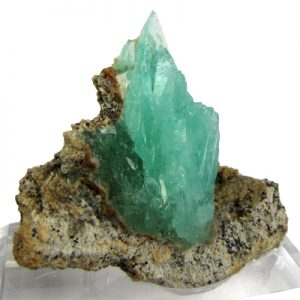Phosphophyllite
Phosphophyllite’s name means phosphate leaf in allusion to both its chemistry and its perfect cleavage. The chemical formula of Phosphophyllite is Zn2Fe(PO4)2 • 4(H2O) (Hydrated Zinc Iron Phosphate) and its molecular weight is 448.40 gm. It is an extremely rare mineral and is one of the rarest gems in the world. Phosphophyllite has a specific gravity of 3.08 – 3.13 (g/cm3) and the refractive index of 1.595 – 1.620 Biaxial ( – ). Phosphophyllite is highly prized by both mineral specimen collectors and gem collectors for its unique and beautifully delicate bluish-green color. As a testament to its rarity, Phosphophyllite has been called “the holy grail of minerals.”
Phosphophyllite is a rare zinc phosphate mineral that is only found in a few locations. Gem-quality crystals only come from the Unificada Mine, Cerro Rico, Potosí City, Potosí Department, Bolivia. The first crystals were found there in the mid-1950’s in the Krause’s vein. None have been found since that is nearly as beautiful. Crystals have also been found at the Cornelia Mine, Hagendorf, Bavaria, Germany but these are very small and pale and do not come close to the amazing color of crystals from Bolivia. Very small, pale crystals have also been found at the Foote Mine, Kings Mountain District, Cleveland County, North Carolina, USA. Both of these locations only produce very small crystals that are too small to facet. Faceted gems are extremely rare because Phosphophyllite crystals are usually kept as mineral specimens. Most crystals found at the famous Bolivian locality are kept by mineral collectors so gem grade crystals are rarely available. Usually, only broken crystals and fragments are used to facet gems so gems are typically small. Phosphophyllite crystals and gems are among the hardest to obtain and the most expensive.
Distribution: From the Type Locality at Hagendorf, Bavaria, Germany. At Pribyslavice, Czech Republic. From the Norrö pegmatite, on Rånö Island, Sweden. Extraordinary crystals in the Unificada mine, Cerro Rico, and from the Siglo XX mine, Llallagua, Potosí; in the Morococala mine, near Oruro, Bolivia. In the USA, at the Palermo #1 mine, near North Groton, Grafton County, New Hampshire; at Red Hill, Rumford, and from Newry, Oxford County, Maine. On Reaphook Hill, near Blinman, Flinders Ranges, South Australia. From Kabwe (Broken Hill), Zambia.
| Category: | Phosphate minerals |
| Chemical Formula: | Zn2Fe(PO4)2 • 4(H2O) Note: material from Bolivia lacks Manganese (Mn) |
| Hydrated Zinc Iron Phosphate | |
| Molecular Weight: | 448.40 gm |
| Composition: | Manganese | 3.06 % | Mn | 3.95 % | MnO |
| Zinc | 29.17 % | Zn | 36.30 % | ZnO | |
| Iron | 9.34 % | Fe | 12.02 % | FeO | |
| Phosphorus | 13.82 % | P | 31.66 % | P2O5 | |
| Hydrogen | 1.80 % | H | 16.07 % | H2O | |
| Oxygen | 42.82 % | O | |||
| 100.00 % | 100.00 % | = TOTAL OXIDE |
| Crystallography: | Monoclinic – Prismatic |
| Crystal Habit: | Crystals tend to be thick tabular on {100}, with {110}, {011}, {102}, {111}, {311}, many other forms, to 13 cm. |
| Twinning: | Common as contact twins giving “fishtail” shapes and as penetration twins, maybe polysynthetic. |
| Cleavage: | Perfect on {100}, Distinct on {010} and {102} |
| Fracture: | Uneven |
| Tenacity: | Brittle |
| Moh’s Hardness: | 3.0 – 3.5 |
| Density: | 3.08 – 3.13 (g/cm3) |
| Luminescence: | Fluorescent; violet under SW UV |
| Radioactivity: | Not Radioactive |
| Other: | Soluble in acids. |
| Color: | Pale bluish green, sea-green, colorless; colorless in transmitted light. |
| Transparency: | Transparent |
| Luster: | Vitreous |
| Refractive Index: | 1.595 – 1.620 Biaxial ( – ) |
| Birefringence: | 0.0210 – 0.0330 |
| Dispersion: | Perceptible, r > v |
| Pleochroism: | X = colorless, Y = pale blue green, Z = pale blue green |


